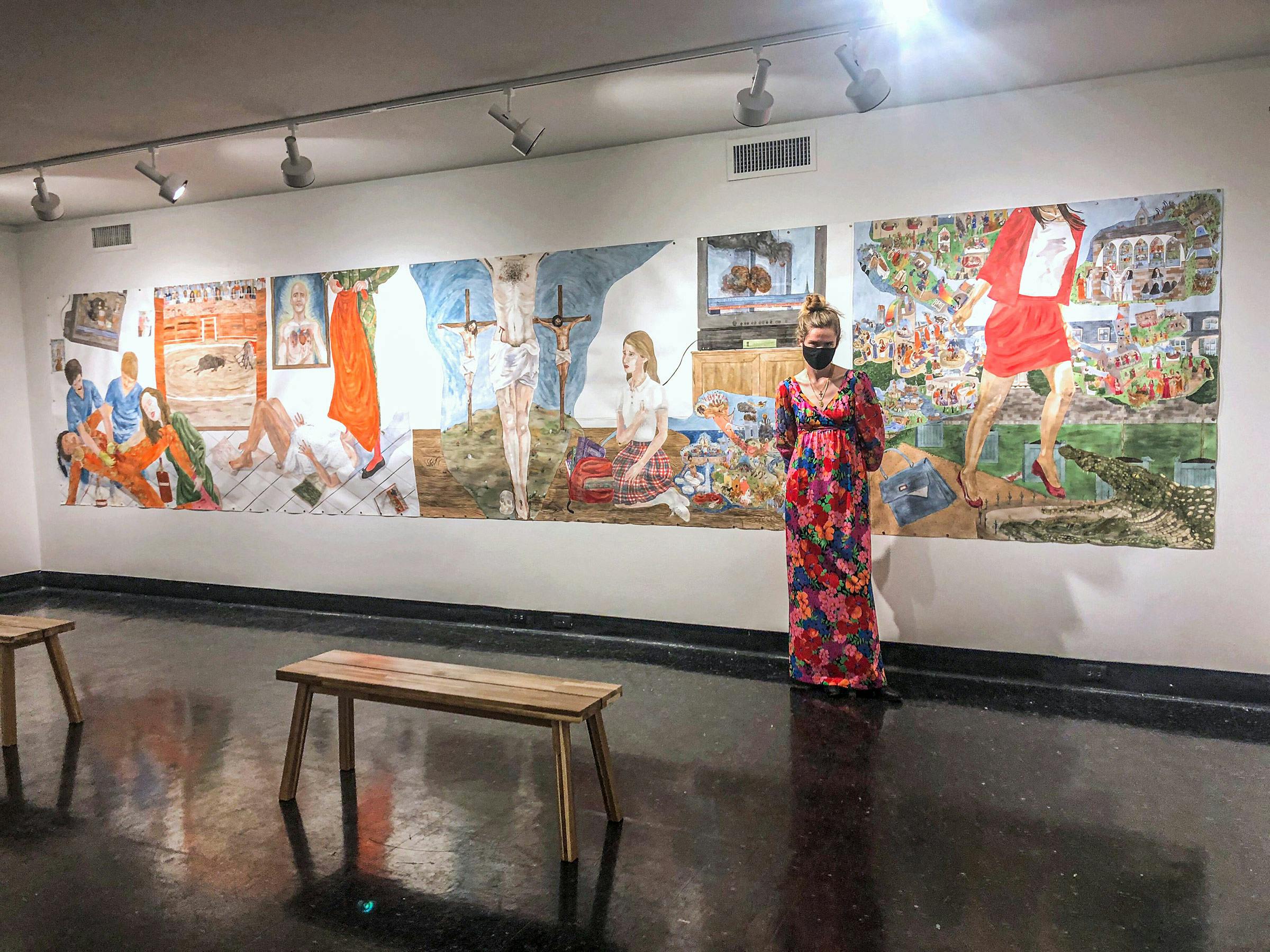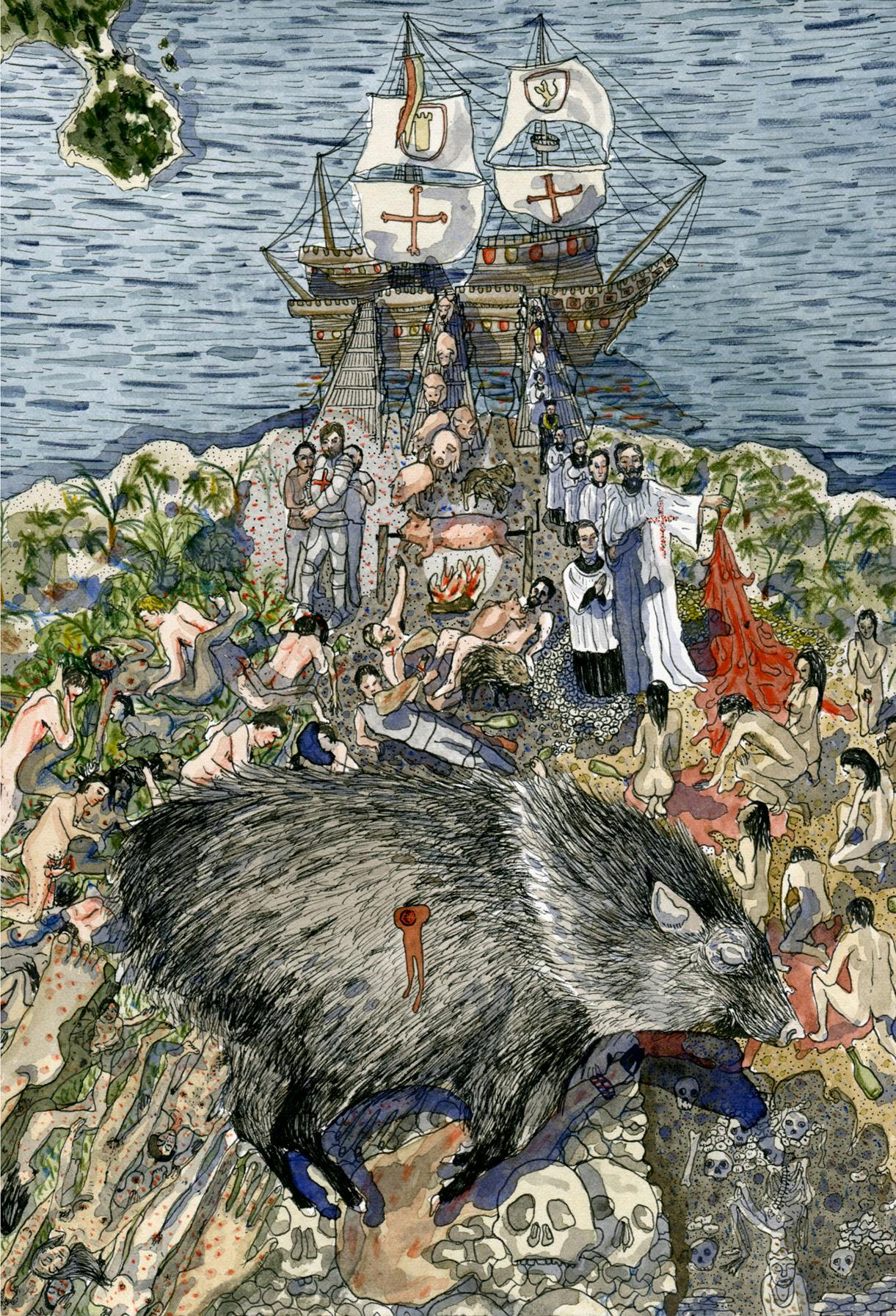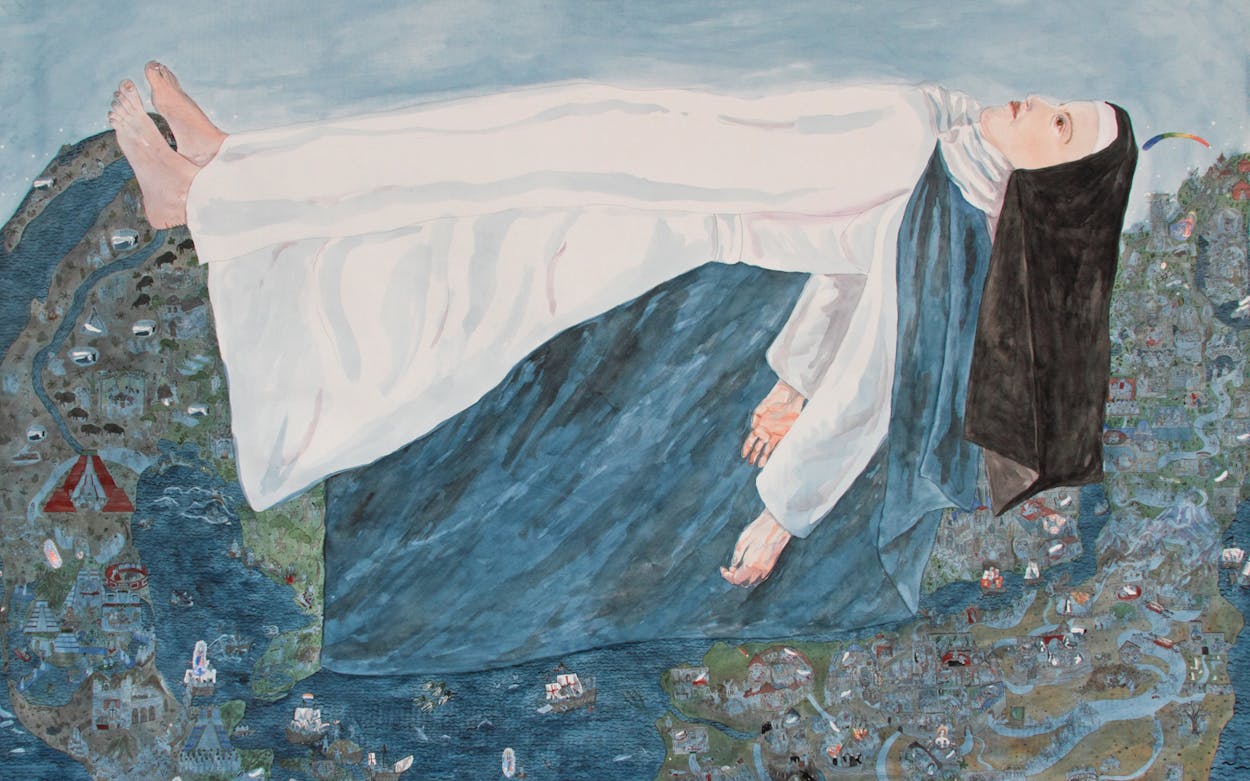Artist Jennifer May Reiland, whose solo show “Carnage” is now on display at Lawndale Art Center, grew up with an eclectic and essentially Houston mix of aesthetic and spiritual influences: Southern Baptist church and Bible camp, exposure to Catholicism through her father’s family, repeated units on Texas history at school, and easy access to great Latin American artworks at the Museum of Fine Arts, Houston. Though Reiland, 31, now lives in New York City, where she is an artist in residence at the Queens Museum, her thematic focus is still very much homeward-looking. Her paintings engage playfully and profoundly with questions of faith, with eros and the human body, with the myths and legends of Texas colonial history, and—as a favorite and especially strange subject—with the mystical bilocating nun María de Jesús de Ágreda.
If there’s a single, straightforward reason to recommend Reiland’s show, which will be open by socially distanced appointment through April 25, it’s the opportunity to see her narrative paintings of María. The seventeenth-century nun, friend to the king of Spain, and author of the much-read book Mystical City of God never left Spain—not in corporeal form, anyway—but claimed to have often visited the New World through a sort of mystical teleportation, “transported by the aid of angels.” Around the same time, reports emerged from New Spain that the Jumano people of what is now New Mexico and West Texas had encountered a beautiful “Lady in Blue” who advised them to seek out religious education from local missionaries. As Texas Monthly reported in 2017, a group in San Angelo has honored María for her supernatural role in evangelizing the West Texas region, though naysayers suggest that her so-called bilocations were a myth constructed by the friar who publicized the story, or by the Jumano in a bid to gain favor and protection from the Spanish.
In Reiland’s depictions, María is a serene, cloudlike presence, seen floating on her back and spanning the width of the Atlantic, or rising as an apparition in a bare cell to reveal the bountiful coast of a virgin country. “I think it’s possible to imagine her as this figure who really believed that this was something that happened,” Reiland says of María’s travels. “So in these works I leaned into that, into the creative version of her where all of this was, in fact, true.”
At the same time, Reiland’s depictions of María as a bridge for an empire nod toward another possible interpretation of the colonial-era tale. If María wasn’t sincere, then, as Reiland puts it, “It’s the story of a huckster too, someone who, in this very American way, took advantage of the situation to become very famous and influential. The propaganda value of this bridging I thought was really interesting.”

Reiland also conveys María’s heady mix of faith and eroticism through depictions of the nun face-to-face with Jesus, exchanging blood between her body and his stigmata (a reference to a trope of colonial-era religious art) and through word-paintings of phrases from Mystical City of God. “The lines sound very romantic in nature, and kind of BDSM, all this stuff about humiliating yourself under the hand of the Lord,” Reiland says of María’s book, which was a best-seller in seventeenth-century Spain. “And she talks about how to maintain your chastity you have to make an inviolable pact with your senses. But she’s totally obsessed with the erotic potential of Jesus’ body. She talks about how she feels his presence physically, and the ecstasy of his presence. It’s all tangled up in her mind.”
Reiland has long been fascinated by the contrast between Catholic religious art, particularly the gory, half-naked church statuary often seen in Spain and Latin America, and the staid Baptist environs of her upbringing and early education. “Seeing these really violent, but also sort of erotic and very human images of the human body in a religious context, was something I basically am still dealing with,” Reiland says. “To me it’s amazing still, because the kind of Christianity I grew up with was so repressive of the human body.”
Reiland’s fascination with Catholic and Spanish art only grew as she studied abroad in Spain in college and eventually married a Spaniard. A few of her paintings directly reference and update well-known historical portraits of Spanish aristocrats. You can also see the influence of medieval European illuminated manuscripts and the fantastical religious scenes of Hieronymus Bosch in the way Reiland’s paintings play with scale, maps, and narrative.
In Reiland’s Discovery of Texas, for example, the eye follows three gangplanks leading down to shore from a Spanish galleon—one dotted with smallpox, one swarming with pigs, and one carrying priests. These three lines join on land in a colonial orgy of sex, blood, death, and pork. Reiland says the painting was inspired by reading about the feral hog problem currently plaguing rural Texas and learning that the hogs were descendants of colonial-era imports from Spain. “I was just like, ‘Holy s—, it’s so perfect. This other legacy of colonialism is these out-of-control hogs,” Reiland says.

Another of Reiland’s religious-narrative paintings, Endtimes 2001, tackles a more contemporary theme. It is set at a Texas Bible camp where real-life scenes of adolescent heavy petting and Ouija board experiments are contrasted with one camper’s bad dreams of raining fire, the Rapture, killer locusts that look like helicopters, and the judging of the saved and the damned.
Reiland was 12 on September 11, 2001, and she remembers the terrorist attacks feeding into a growing obsession with the end times in her religious community, including at River Oaks Baptist School, where she attended from first to eighth grade. “There would be these florid descriptions at school of the four horsemen, and everyone’s heads were going to be cut off by Jesus,” she says. “And the locusts—the proof of all this was that there’s this passage in Revelation about giant locusts, which are like locusts but they’re not locusts. So, that was supposed to be helicopters.” These apocalyptic theories terrified her for a few years, she adds, until she realized that she didn’t actually believe in them.
Faith, however, is a slippery subject in Reiland’s work. Her art, which mixes heavy religious motifs with a sweet, homemade, sketchbook quality, is not the work of a true believer, but neither can it be described as skeptical or materialist. Her imagination is locked on overdrive, with a tone suspended somewhere between desire and doubt, myth and history, truth and reconciliation.
“I’m always interested in ambivalence,” Reiland says. “If you feel ambivalent about something, I think that’s the thing you need to explore through art. So feeling ambivalent about religion, about Texas, Spain, the history of the United States, the history of the Americas—that, for me, is always something to push into.”






